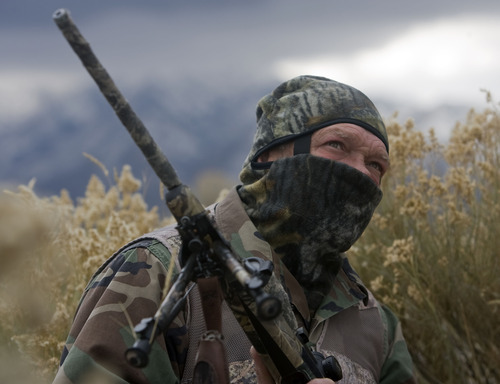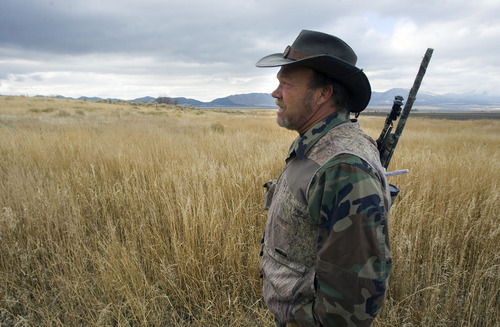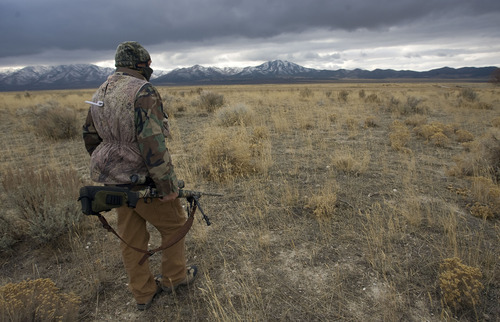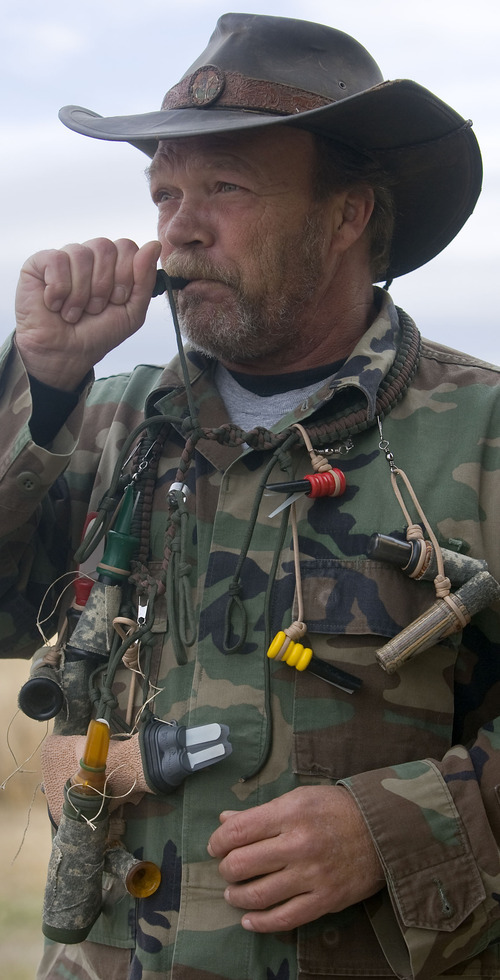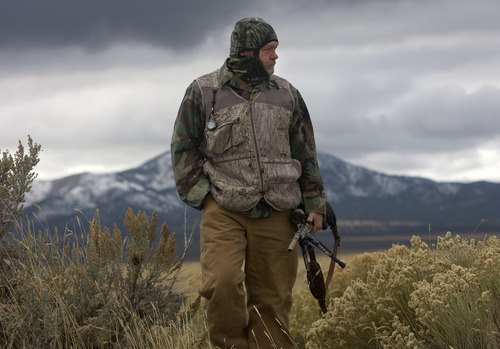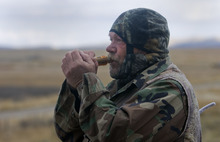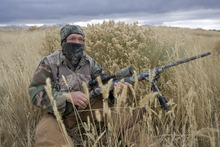This is an archived article that was published on sltrib.com in 2011, and information in the article may be outdated. It is provided only for personal research purposes and may not be reprinted.
Vernon • They have complex social structures, multi-layered vocabularies and are shrewd predators.
Bill Keebler has taught himself a lot about coyotes. And, for a price, the Tooele County outfitter will guide would-be coyote sport hunters to the hard-to-find animals that legally can be shot year-round.
The best time for hunting coyotes is winter, Keebler said. Their coats are thicker for hunters seeking a trophy. And because food is more scarce, the normally nocturnal animals spend more daylight hours on the move. They're known to eat mice and rodents and even berries and grasshoppers. They are true omnivores.
Keebler has roamed Utah's west desert enough to know where to find the tricksters. He can follow their trails, even when they walk in deer tracks, and knows their scat.
"They can hear a mouse squeak at 300 yards. And they can see you blink from 100 yards," said the 52-year-old Georgia native and lifelong hunter who relocated to Utah's vast outback six years ago.
It's far more daunting than deer or duck hunting, Keebler explained.
"A deer, you can walk right up to 'em and then shoot 'em," he said. "But the coyote is one of the most challenging things I've ever hunted. They're predators. They do the hunting."
The basics of coyote hunting are camouflage and calls. Keebler sits low near sage brush and grease wood in light-gray camouflage clothing covered with coyote-urine scent. Even his rifle is camouflaged. He blows through a reed mouth piece to bring the animals to him. With his set of a dozen or more reed calls, Keebler can create more than 100 different sounds that speak to coyotes.
He can make the sound of a female coyote attracting a mate. He mimics the call of a young, male coyote in a new territory, or even a rabbit in distress.
"I'm painting a picture in the coyote's mind that will draw them in," he said.
—
Controversial predators •Coyotes are reviled as varmints by agricultural interests, particularly by sheep ranchers. During calving and lambing season, they are known to attack cows and ewes and eat their offspring during or right after birth. But they also keep the rodent population down. And cattle and horses can be seriously injured stepping into gopher holes.
"When it's birthing time, the ranchers want all the coyotes dead," said Keebler. "But when it isn't calving season, they want them alive because they eat the gophers."
Like many states, Utah operates a predator control program. The Wildlife Services Program is run jointly by the Utah Department of Agriculture and Food and the U.S. Department of Agriculture, said state director Mike Linnell.
Utah's livestock protection program has a budget of about $500,000 and kills some 4,000 to 5,000 coyotes annually, he said. But it's not for sport. Wildlife Service personnel respond to complaints from ranchers and work with the Utah Division of Wildlife Resources to protect mule deer herds from coyotes.
"Our objective is to target very specific animals," Linnell said. "For us, it's not about the numbers [of killed coyotes], it's about protecting livestock."
About 60 percent of coyotes killed through the program are shot from the air. The balance are taken by shooting and trapping on the ground. "Usually, aerial hunting is the most effective and cost efficient," Linnell said.
But Gina Farr, of the California-based Project Coyote, said hunting the animals is the wrong strategy to reduce coyote numbers.
In a coyote community, or pack, only the alpha male and alpha female reproduce, she explained. On average, they will have one litter of four to six pups per year. Only 30 percent will survive to one year.
But if either the alpha male or alpha female are killed, or even other members of the group, the remaining adults in the pack will reproduce. That means a lot more offspring.
"Coyotes have reproductive compensation," she said. "Disturbance of their social group causes more animals to come into heat. They respond to hunting efforts by having more pups."
For more than a century, coyotes have been vigorously hunted, Farr said. The outcome is a burgeoning population over a vastly increased range.
The federal Wildlife Services program kills about 90,000 coyotes a year in the United States, she said. And yet populations are up. "It's a never ending killing machine," she said. "But we don't look for new solutions even when the old ones don't work."
Other methods of protecting livestock have been successful, she said. Pregnant ewes can be put in a protected area, for example. And llamas, donkeys and guard dogs are effective at keeping coyotes at bay.
John Shivik, mammal coordinator for the Utah Division of Wildlife Sources, agreed that trying to control coyotes through hunting is futile. To have any impact, 70 percent of a population would have to be killed every year for a number of years, according to Shivik. But that strategy isn't practical.
"Controlling coyote populations through hunting them is like digging a hole in the ocean," he said.
—
Sport hunting • For Keebler, coyote hunting is a pure sporting experience and he doesn't pay much to attention to the politics surrounding it. As part of his service, Keebler will guide hunters who want a pelt or bounty offered by most rural Utah counties, or photographers who wish only to shoot coyotes with a camera.
"I teach people to appreciate and respect nature. On my hunts, there is no alcohol, no drugs and no littering," he said. "This is not a bunch of dumb rednecks out here shooting. I'm doing it for sport and to teach other people how to do it and educate people about coyotes."
Coyote hunting is growing in popularity, Keebler said. But most would-be coyote hunters have little idea how to approach the sport. Most novices are too noisy and scare the critters away. Others, who may know enough to attempt calling them, end up teaching the predators which reed calls to ignore.
"There is no instruction manual for this. It's very hard without experience to get a coyote," he said. "If they have no experience, I offer training. But even then, you can't expect to go out and get a coyote the very first time."
More online
Learn more about coyote hunter Bill Keebler • http://www.crittergitteroutfitters.com
Learn more about coyotes and livestock protection • http://www.projectcoyote.org


